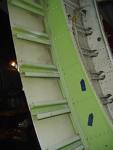|
We have decided to concentrate on the Aircraft industry, specifically the airplane fuselage. The fuselage is the main body
of the airplane. The fuselage serves several very important roles. It carries the passengers and cargo. It also serves
as the reference or stabilizing point for all of the parts that move or create lift for the aircraft. Therefore, the integrity
and dependability of the fuselage is crucial for the functionality of an airplane.
The fuselage is composed of two main parts. These two parts are the main skeleton or frame and the outer body wall.
Al 6013 is a very strong yet flexible material. However, its strength is less than the aluminum 2000 and 7000 series which
are known for their superior strength. Therefore, 6013 is unlikely to replace these alloys’ use in structural and
framework components. Thus, we have decided to focus on the fuselage panels. Here the main benefit of Aluminum 6013 will
be utilized. Its ability to resist corrosion and stress corrosion cracking while still being extremely lightweight, compared
to steel and other common material, and strong is a perfect use for a component that is both important for durability and
longevity as well as structure and safety. These panels can be made using sand or continuous casting or sheet forming. The
panels can then be reworked to a cylindrical shape and then heat treated to relieve residual stress and harden the material.
These panels will then be joined to the main frame of the aircraft using rivets.


|
